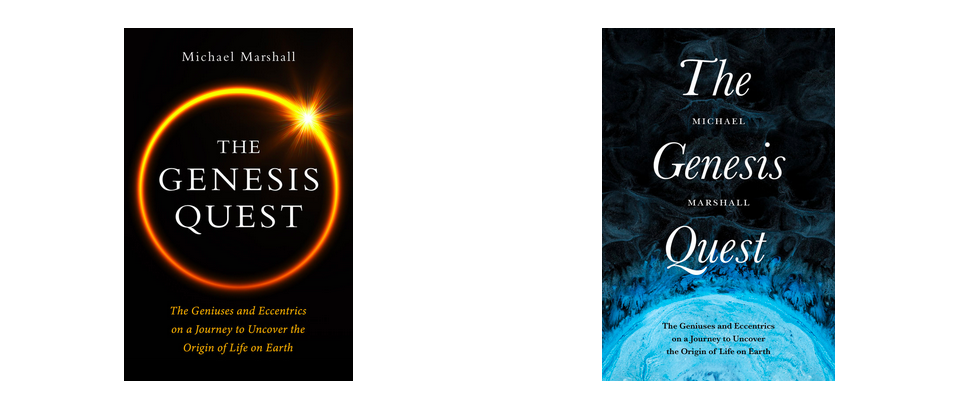| My first book The Genesis Quest is out in paperback in the UK today. It's been a long hard road to get here: it turns out releasing your debut book in the middle of a society-upending pandemic is really quite difficult. But it's here now, the reviews are wonderfully positive, and I'm still very proud of it. I hope you all enjoy it. You can get your copy from all good bookstores, but I'll particularly draw your attention to bookshop.org, where I have an actual page all of my very own. If you buy from there, I will earn a slightly higher percentage than if you buy elsewhere. |
|
I have two pieces of good news about my book The Genesis Quest.
We learned in late March that it has been longlisted for the 2021 Hughes Prize. This is a biennial award given by the British Society for the History of Science, for "the best book in the history of science (broadly construed) published in English which is accessible to a wide audience of non-specialists". Previous winners include Andrea Wulf's The Invention of Nature, one of my favourite books of the last decade, so even to be longlisted is wonderful news. The shortlist will be announced in June 2021. We also learned that materials scientist and broadcaster Mark Miodownik loved the book, and he has kindly gone on record saying: "This is an incredibly absorbing and insightful book about the most important scientific question of our age." Mark is a terrific science communicator so his good opinion of the book means a lot to me. This is all very encouraging, as we're gearing up for a paperback edition later this year!
I've written a lot of articles about the covid-19 pandemic, for a range of publications. To keep track of them all, I've started a long thread on Twitter.
Over the last few weeks I've released two new videos about the origin of life on Earth, as part of my ongoing virtual book tour to support The Genesis Quest.
If you'd like something short, I recorded a little YouTube video for my US publishers, the University of Chicago Press. It's part of their Author At Home series and you can watch it here, or embedded below. In it I explain what the book's about and what it says, and about how exploring the origin of life pushes at the boundaries of our knowledge.
Alternatively, if you'd like something a bit more in-depth, I gave an hour-long online talk to the Sidmouth Cafe Scientifique
To coincide with its US release, The Genesis Quest has been reviewed in The New York Review of Books. All I can say is wow: this is a seriously in-depth, engaged review that offers a really rich picture of the book.
It's written by Tim Flannery, an Australian biologist and environmentalist with a very wide-ranging set of interests. I'm really pleased he's found so much to engage with. Here's a sample passage: "Marshall’s book focuses on the chemical research—from the first speculative insights made by brilliant minds to the complex experiments that have increasingly dominated the field—into life’s origins. It’s a fascinating and challenging story, and leavened with mini-biographies, the best of which are based on his own interviews with his subjects." Read the whole review here I went on the Probably Science podcast to talk about The Genesis Quest, which is out in the US this week.
Probably Science is a light-hearted science podcast hosted by Matt Kirshen and Andy Wood, who are both professional comedians based in California. Full disclosure: Matt is an old friend from university. We talked about how life might have begun, the scientists who have explored the question, the long-running controversies in the field, and whether there is life elsewhere in the universe and if so what it might be like. There's a technical glitch partway through where Matt lost his connection to the rest of us, which evidently wasn't possible to edit out, so you get to hear our behind-the-scenes "how shall we fix this?" conversation. But we do then get back to the point! You can listen to the episode on their website, and on all the usual podcast outlets like iTunes and Patreon.
I've made two videos to promote my book The Genesis Quest. Each gives a potted summary of one of the book's core ideas, so I thought I'd share them here.
The first video was made for the Global Science Show, a monthly event on Twitter in which dozens of people share videos explaining their favourite areas of science. Thanks to Sam Langford for inviting me to take part in the September event! I made a video asking how life on Earth began, which summarises the core argument of the book. You can watch it on YouTube, or here:
The second video was made for MajorTim.space, which is a family-oriented site with a focus on space - inspired by British astronaut Tim Peake. I made a video asking when life on Earth began, which tries to convey just how huge a span of time 3.5 billion years really is. Thanks to Amelia Piper for inviting me to do this, and for editing the video! You can watch it on the MajorTim.space website, or it's embedded here:
My book The Genesis Quest has been favourably reviewed in The Biologist, the official magazine of the Royal Society of Biology. The review is by Professor Jim Lynch of the University of Surrey and it's very positive. Sample quotes:
"The book's distinctive style comes from well-researched analysis of the behaviour and lifestyles of the various scientists who have contributed to this fascinating and uniquely difficult question." "This book is an extremely stimulating read and I recommend it most strongly to scientists and laymen alike." Read the full review in The Biologist  Today, 20 August 2020, is the UK publication day for my first book The Genesis Quest! The book is the story of scientists' struggle to understand how life began on Earth. It's a mystery story with a fascinating cast of real-life characters, and an exploration of one of the biggest questions in modern science - a question that has fascinated me for years. From the back cover: "By asking how life came to be, we are implicitly asking why we are here, whether life exists on other planets, and what it means to be alive. This book is the story of a group of fragile, flawed humans who chose to wrestle with these questions." The Genesis Quest has been a labour of love that's taken three years, plus a decade of journalistic legwork to amass the knowledge and contacts to attempt it. I'm so excited for you all to finally be able to read it. A huge thank-you to everyone who has helped me along the way. The book wouldn't exist without you! An equally huge thank-you to everyone who has already bought it. Your support means so much! Also, I, er, I do have a few ideas for a second one... More about The Genesis Quest, and a list of places to order it, on this page I'm happy to share a new review of my book The Genesis Quest (to complement the two already released). This one comes from science historian Luis A. Campos at the University of New Mexico, author of Radium and the Secret of Life. Campos says:
"The Genesis Quest recounts remarkable episodes in the history of attempts to scientifically understand the origin of life. Combining exceptionally clear expositions of what is scientifically at stake, distinctive humor, and a roving eye for the telling anecdote, this is anything but a tedious scientific genealogy. Marshall has a flair and talent for explaining each individual experiment and its intellectual context. The Genesis Quest offers a well-done romp through some fascinating and complicated terrain." |
About this blog
All opinions here are mine and may not reflect the views of my employers. Archives
August 2023
Categories |






 RSS Feed
RSS Feed